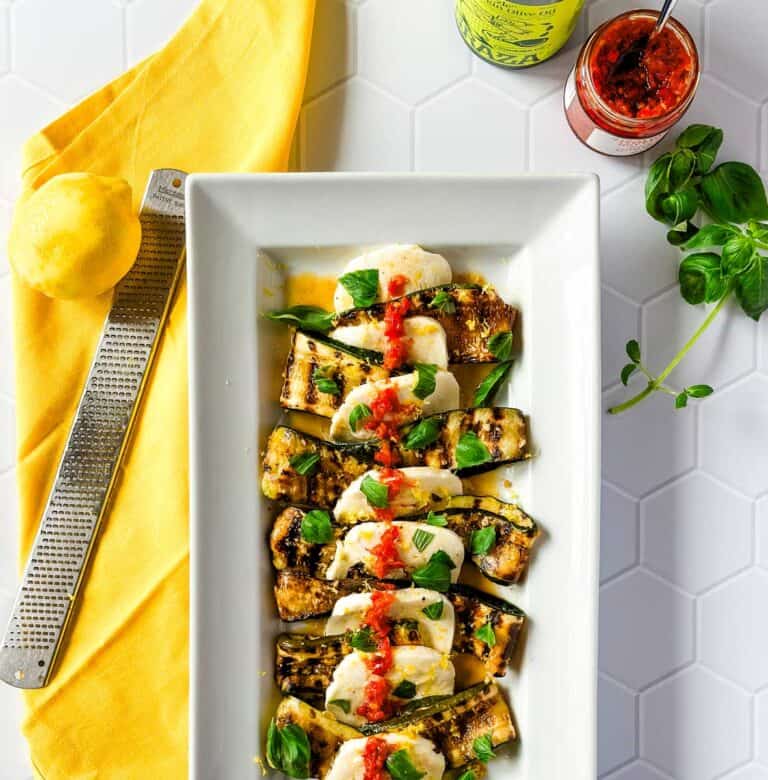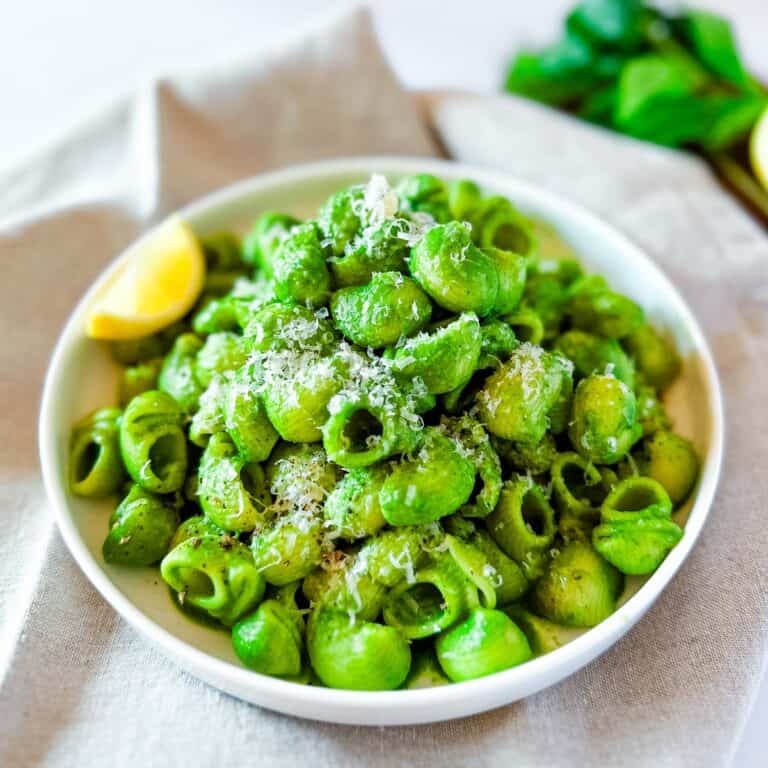Easy and Best One-Pan Halibut with Minted Pea Puree
This one-pan halibut is the perfect combination of ease, speed and sophistication. Based on classic French technique, this method of cooking fish removes any of the intimidation, as it starts in a cold pan with aromatics and ends with beautifully steamed fish and a delicious sauce. What’s more? The fish is ready in less than 5 minutes!
Paired with a Spring pea puree with notes of mint, basil and lemon, this is truly a weeknight masterpiece.

💌 Save This Recipe
I'll also send you other recipes I know you'll love. Unsubscribe at any time.
I learned this method of cooking fish in culinary school, what feels like a hundred years ago, and it is as striking to me today, as it was then.
Why striking? THE SIMPLICITY. But also the complex flavors. As a matter of fact, in my opinion, this dish is a perfect intersection of low effort and maximum flavor.
Over the years, I have loved teaching this method to students, as it removes so much of the intimidation that many find around cooking fish.
Classics are classics for a reason. And this method of preparing halibut is the perfect case in point.
And if you’re looking for some other seafood options, consider this Slow Roasted Salmon with Spring Herb Sauce, Pan-Roasted Pistachio Crusted Fish, or these Sheet Pan Shriimp Tacos with Roasted Pineapple Salsa.
Why I think you’ll love this recipe:
Recipe ingredients
You’ll need the following ingredients to make this super easy one pan halibut recipe :

Ingredient Notes
Most of the ingredients to make this halibut are easy to find and readily available at most any grocery store. Seek out a fish monger or reputable grocery store with a great seafood counter to find your halibut.
And, if you’re able, swing by your local farmer’s market to grab any of the fresh ingredients that you can. It supports your local food economy and there’s no question that the flavor will be best.
Here are a few ingredient notes:
Halibut: Be sure to seek out a reputable source for your fish – a fish monger or a grocery store with a great seafood counter full of high quality fish and shellfish. Make sure the fish is on ice and the ice should look clean. The fish should look firm, moist and not look ragged around the edges. And the fish should never smell fishy. If you don’t have access to fresh halibut (which has actually been previously frozen), don’t sweat it – you can use the frozen – just make sure it is thawed completely. Alternatively, you could use another meaty, but flaky white fish like cod. Just know that you may need to adjust the cooking time according to the thickness of the fish. I am a huge fan of the Seafood Watch website for all information concerning fish selection and sustainability – it is a fantastic resource.
Stock: You can use fish stock, chicken stock or vegetable stock – whichever you have.
White wine: Use a DRY, NOT SWEET white wine for best results. For this dish, I really like a sauvignon blanc – it’s dry and light and pairs well with citrus and herb notes.
peas: Frozen peas or fresh peas, when in season, will work in this recipe. If you choose to use fresh peas, make sure they are sweet, and know that you will need to adjust the blanching time by cooking them an extra minute or two.

How to make One-Pan Halibut with Minted Pea Puree: STEP BY STEP
Be sure to check out the full recipe and ingredient list in the recipe card below
Steps 1 & 2:
Bring a large saucepan of well salted water to a boil to blanch the peas.
Next, prepare the rest of the ingredients: mint, basil, parsley, shallots, and lemon zest.


Steps 3 & 4:
When the water has come to a boil, add the peas and cook for one minute. Drain and add them to a blender.
Add the rest of the ingredients for the puree to the peas: butter, chicken stock, mint, basil, parsley, lemon zest, salt and pepper. Blend until completely smooth.


Steps 5 & 6:
Grab a saute pan (cold) and scatter the chopped shallot and one tablespoon of the parsley on the bottom.
Next add the halibut filets on top and season them with salt and pepper. Then, add the wine and stock to the pan around the filets.


Steps 7 & 8:
Bring the saute pan over to the stove. Cover the pan tightly with foil or a lid and bring to a boil. As soon as the liquid reaches a boil, reduce to a simmer and cook about 4 minutes.
To check to see if the fish is done, pull back the foil and press one of the filets with your finger – the flesh of the fish should be slightly firm and bounce back when you touch it. Turn off the heat. *SEE VIDEO BELOW.


Steps 9 & 10:
When the fish is done, remove the filets from the pan, place them on a plate and cover them to keep them warm.
Return the pan to medium low heat and reduce the liquid until it starts to thicken a little and reach a slightly syrupy consistency.
Whisk in the cold butter and turn off the heat.


Steps 11 & 12:
Add the remaining tablespoon of chopped parsley. *It will seem like very little sauce, but you only need a little. As a reduction sauce, it has very concentrated flavor, so a little goes a long way.
Finally, serve it by making a base of puree on your plate, top with halibut, and spoon a little sauce over top.



Chef Notes & Tips
- Resist the urge to overcook the halibut! To check the fish, gently press with your index finger – the fish should feel slightly firm and bounce back. The contrast to keep in mind is if you touch the fish when it is raw — it doesn’t have the same spring-back. *SEE VIDEO BELOW.
- Add the stock in increments to the pea puree to get the consistency you desire. Depending on whether or not you use fresh or frozen peas, the amount of liquid can be different.
- Reserve a few of the blanched peas to scatter around the plates to vary the texture and give a nice look to the dish.
How to tell when fish is done
Storage & Reheating
STORAGE: Store the fish and the pea puree separately in airtight containers for up to 3 days. Please note that the pea puree will start to darken over time – it is still delicious!
REHEATING: I would recommend reheating the fish and the puree separately, as the fish will take longer to reheat. Microwave or reheat the puree in a small saucepan over low heat. Reheat the fish by placing it in a pan on the stove with a little water or stock over medium heat, covered, until warmed through. You can also reheat the fish in the microwave in 30 second intervals until warmed through, though the stovetop method is a little gentler.
Substitutions & Variations
Halibut: You can substitute another white flaky fish for the halibut. If it is a thinner fish, you will need to reduce your cooking time, accordingly. You could even use salmon. I would not recommend more meaty fish like swordfish or mahi mahi.
Minted Pea Puree: You can serve this with a number of different things – as simple as steamed rice or quinoa or a bed of roasted vegetables. I chose the pea puree because I love the flavor combination and it’s really quick and easy to make.

FAQs
I hope you love this ONE PAN HALIBUT! If you make it, be sure to leave a rating so I know how you liked it!
The Recipe

Easy and Best One-Pan Halibut with Minted Pea Puree
Ingredients
- 1 shallot (finely chopped)
- 2 tbsp parsley (finely chopped and divided)
- 4 halibut (filets)
- 1/4 cup dry white wine
- 1/4 cup stock (fish, chicken or vegetable)
- 2 tbsp butter (cold)
- kosher salt and black pepper
- olive oil (to drizzle on finished dish (optional))
Pea Puree
- 4 cups frozen peas (or fresh when in season)
- 1/4 cup stock (chicken or vegetable)
- 1 1/2 tbsp butter (or olive oil)
- 2 tbsp mint (roughly chopped)
- 2 tbsp basil (roughly chopped)
- 2 tbsp parsley (roughly chopped)
- 1 lemon (zest only)
- 1 tsp kosher salt
- 1/2 tsp black pepper
Instructions
- Bring a pot of well-salted water to a boil (to blanch the peas).
- While the water is coming to a boil, prepare all of the herbs. Roughly chop the mint, parsley and basil for the pea puree. And finely chop the parsley for the halibut. Lastly, zest the lemon.
- Add the peas to the boiling water and cook for one minute. Remove and drain and then add them directly to a blender.
- Add the rest of the ingredients for the pea puree to the blender – stock, butter, mint, basil, parsley, lemon zest, salt and pepper. Blend until completely smooth and set aside.
- Next, grab a cold saute pan and sprinkle the shallots and 1 tablespoon of the parsley over the bottom. Add the halibut filets on top and season them with salt and pepper. Then, pour the wine and stock around the filets.
- Cover the pan tightly with foil or a lid and turn on the heat to high. When the liquid comes to a boil, reduce the heat to low and let it simmer until the fish is done – about 4 minutes, depending on the thickness of your filets. You will know the fish is done when it is firm to the touch and bounces back when you press on it.
- Remove the fish from the pan and onto a plate, covering it to keep it warm.
- Return the saute pan to medium heat and let the liquid simmer until reduced to a thicker consistency.
- Add the cold butter and remaining tablespoon of parsley and whisk it until melted – this will both thicken and emulsify the sauce. Remove from the heat. Note: the amount of sauce will be small – this is a reduction sauce that has a very concentrated flavor, so a little goes a long way.
- To plate, add a generous amount of the pea puree to the base of the plate. Add halibut on top and then spoon a small amount of sauce on top. ENJOY!
💌 Save This Recipe
I'll also send you other recipes I know you'll love. Unsubscribe at any time.
Video
Notes
- Always look for fish that is on clean ice, is moist and firm, and NEVER smells fishy.
- Use a high quality stock for the halibut. A small amount is used and is reduced leading to a very concentrated flavor, so it’s important to start with something that tastes good to begin with.
- Make sure the wine you use is DRY and NOT SWEET. Just like the stock you use, the wine should also be of good quality. This does not, however, mean expensive. A good gauge is that it should be drinkable. Again, a small amount is used and reduced, so it’s important to start with something that tastes good to begin with.
Nutrition
Did you make this recipe? I want to know!
I’d love to hear from you! Consider leaving a comment and rating below.
My readers love to read your reviews, adaptations and suggestions! Have a question? I’ll personally respond within 24 hours. Please share any photos on instagram and tag me @nataliemarblecooks so I can see your creations!






Can the pea puree be made in advance (a day ahead)?
Yes, absolutely! Just store it in an airtight container in the refrigerator and then gently reheat it before you serve it.